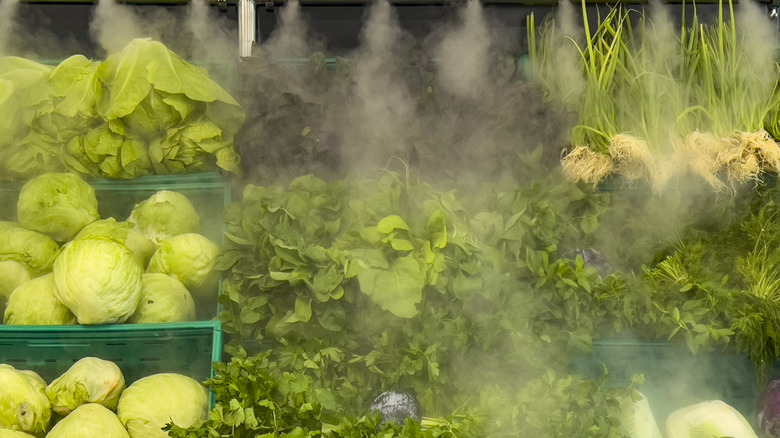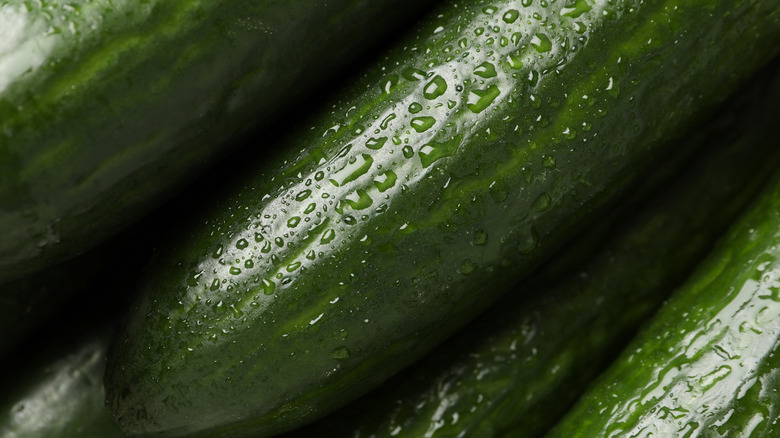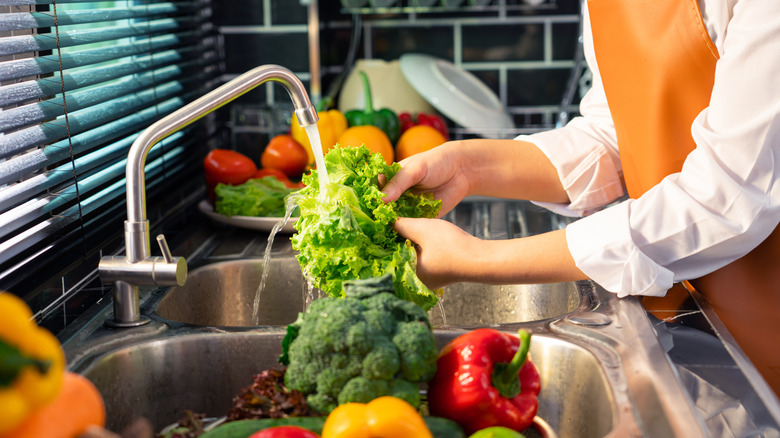The Strategic Reason Grocery Stores Mist Their Vegetables
When trying to pick the freshest groceries, namely vegetables, you might fall into the trap buying water-misted veggies. Grocery stores who mist their vegetables know full well that it creates a whimsical image of dewy plants growing in a sunny field. Shoppers are then more likely to believe the misted veggies are fresher than dry or bagged produce, even if that isn't the case. You might wind up grabbing lots of misted veggies and putting them in your cart, without knowing that your spinach and other greens are actually a month or two old.
It turns out that misted produce isn't any fresher, better-tasting, or superior in any way. Grocery stores don't mist veggies to keep them fresh — it's mostly about appearances. Another reason for this practice concerns product weight. Misted veggies are generally among produce sold by the pound, and saturating them with water adds weight. Waterlogged veggies become up to 25% more expensive than dry ones.
Additionally, you might be peeved to find out that misting makes veggies go bad faster. Even though some produce needs moisture to remain crisp, that same moisture provides a breeding ground for bacterial growth and, particularly in the case of leafy greens, makes them limp and soggy. Even if the veggies aren't looking so sad when you buy them, it's only a matter of time before they spoil, forcing you to go buy more. This is yet another reason why misting results in more profits for grocery stores.
How to counteract veggie misting
Even though grocery stores think they're being sneaky by misting vegetables to make them more appetizing (and more expensive), shoppers can play that game, too. To avoid being fooled, you should keep a mental note of how vegetables should look and feel when they're at their best, and don't stray from those standards as you shop in the produce department. For instance, if snap peas have blemishes on their pods or feel even the slightest bit soft, they're on the cusp of spoiling, regardless of how dewy and appetizing they look.
If you need a certain vegetable, but it's only available in a misted section, you can use a few other tricks to counteract the mist. Before you take produce to self-checkout or regular checkout, be sure to shake off any excess water. To be clear, this won't dramatically cut the cost of your veggies, but it will minimize how much you're paying for purely water weight. This will also reduce the amount of moisture in the bag, helping your produce stay fresh for longer if you intend to store it in said bag.
Don't assume a grocery store misting means clean veggies
There's another important factor in making sure your vegetables are at their best. Whether you buy veggies from a misted bin or in a bag labeled "triple-washed," you should never assume that your produce is actually clean. For one, a little misting every so often doesn't even come close to meeting the USDA's recommendation. You should be rinsing fruits and veggies under running water at the minimum. On a similar vein, you don't know how many employees handled the produce during transportation and restocking, let alone how many other shoppers have had their hands in the bin.
Besides the germs your produce might pick up in the grocery store, you can't guarantee that produce labeled as pre-washed was ever washed at all. For all you know, those tomatoes went straight into a box after being picked –- along with any bugs, bacteria, or fungi that might have hitched a ride. Misting will only exacerbate bacterial and fungal growth, and turn any dirt present into mud. To keep yourself safe, always be sure to wash produce thoroughly before cooking and eating, whether you clean cauliflower with salt and vinegar or take a scrub brush to potatoes.



